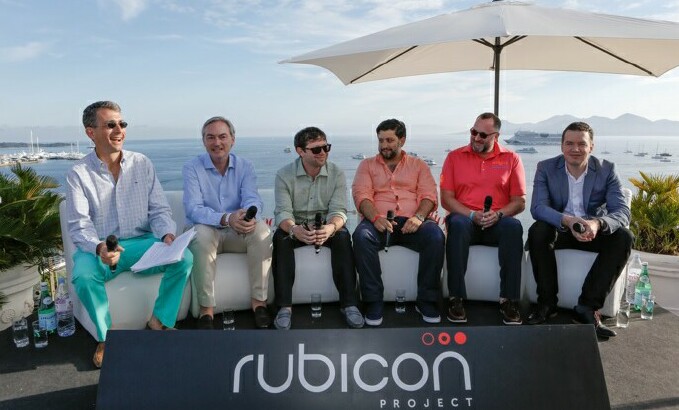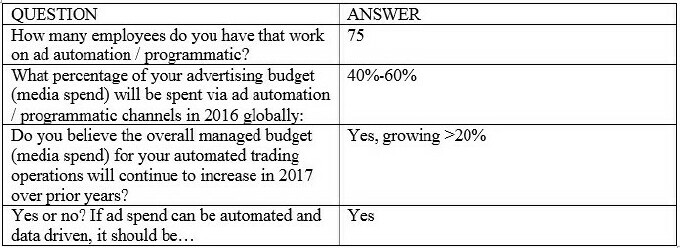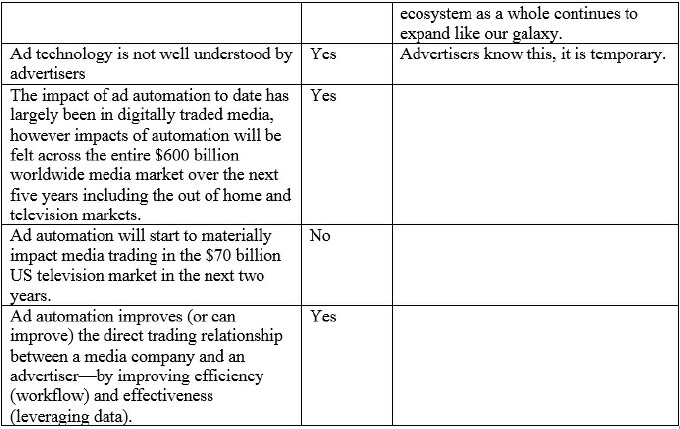Art Muldoon of Accordant Media on Advertising Automation and Programmatic

Jay Sears, Senior Vice President Marketplace Development of Rubicon Project discusses advertising automation with Art Muldoon (pictured above), CEO and Co-founder of Accordant Media as part of a series of buyer conversations on the topic.

(Left to right: Jay Sears; Art Muldoon; Oleg Korenfeld, Executive Vice President, Ad Tech and Platforms, Mediavest | Spark; Hossein Houssaini, Global Head of Programmatic Solutions, Havas Media Group; Mac Delaney, Head of Programmatic, Merkle, and Paul Dalton, Chief Media Officer, International DigitasLBi at the 4th Annual Automated Advertising Panel this summer at Cannes. Click on the links above to read Jay's interviews with other members of this group.)
JAY SEARS: What do you read to keep up with politics, art and culture?
ART MULDOON: The New York Times, Yahoo!, Wall Street Journal, Accordant Media employees
SEARS: What do you read to keep up with friends?
MULDOON: Facebook, LinkedIn, ESPN
SEARS: What do you read to keep up with the advertising technology industry?
MULDOON: AdExchanger, Exchangewire, The Drum, MediaPost, AdAge, AdWeek, BusinessInsider, TechCrunch, WSJ, NYTimes
SEARS: What’s your favorite commercial of all time?
MULDOON: Coca Cola Mean Joe Greene, 1979
SEARS: With regards to advertising automation, what are the three or four biggest trends you expect to impact companies in 2016 and 2017?
MULDOON:
- Managing user-level data to unlock cross-channel / cross-device targeting and attribution. Programmatic marketing is enabling marketers to break down soloed media targeting through the organization and management of data at the user level. This enables more efficient cross-channel media buying and helps marketers understand how their best prospects and loyal customers engage in messaging.
- More marketers ride shotgun. Marketers expect greater access, control and accountability into their media spend. They need to drive more efficient results that will require greater use of first-party data. That means a more activist, collaborative role than they’ve traditionally pursued with their agencies. They don’t need to drive the car, but they want to be an engaged navigator.
- Programmatic quality, transparency. Although fraud is an issue, and there are unscrupulous operators in our industry, skilled programmatic buyers using sophisticated tools and practices can engage in high-quality, scalable, automated media transactions that help marketers achieve greater scale and clearer campaign results.
- Mobile video. The year of mobile has already come and digital video is among the fastest growing programmatic segments. This makes mobile video the killer solution for programmatic advertisers, reaching highly engaged mobile users with high degree of targetability and accountability.
SEARS: With regards to advertising automation, what are the three most overblown topics that you wish would just go away?
MULDOON:
- The Deterministic vs. Probabilistic data debate. It’s a false choice. Advertisers should use both. Deterministic gives you truth sets, probabilistic data gives you scale and/or portability across platforms. If you’re really doing it right you should be talking about how the two datasets complement each other -- i.e. evaluating match rates, performance indicators and overlap, and ingesting data from multiple sources (ad serving data, clients, third party vendors) to figure out right mix of data models per advertiser and per use case.
- The fears being propagated by programmatic naysayers. I may be biased about this. There are very positive, high-quality audience-targeted solutions being practiced by skilled media experts who are proving that programmatic is an advertising game-changer. However, success requires dedicated skills and access to proper tools to manage technology, data and advertising objectives. There is a chorus of naysayers who may not understand or are not willing to make the commitment (investment, training) and are telling their stories about being part of the roadkill in a rapidly evolving industry.
- Programmatic Native as a separate channel/tactic from display. Native is really just part of the variety of display advertising options. Programmatic native can be a great component, and we see good performance from them, but do we really need to price/evaluate them for clients as something other than an innovative approach to display? Programmatic native looks and acts more like banner ads than advertorials, but it more frequently gets lumped together with the advertorials, not the banners.
SEARS: Describe your company or division and then tell us the three most common issues you help clients with in respect to advertising automation and programmatic trading.
MULDOON:Accordant Media makes advertising investments more successful for marketers by unlocking the value of audience data. Through a unique combination of sophisticated data management and activation technologies, expert service and industry-leading transparency, Accordant provides marketers more insights and accountability to drive (cost) effective results at scale. Accordant Media is headquartered in New York City and has additional offices in Chicago, San Francisco and London.
Three most common issues we help clients with are:
- Organizing marketer’s audience data for cross-channel digital media activation.
- Moving campaign analytics and insights from a last-touch, siloed view to an integrated, multi-touch discipline.
- Showing we care about educating and empowering marketers to unlock the value of programmatic media.
SEARS: Tell us about your company or division.
MULDOON:

SEARS: The majority of ad technology companies (relatively small, unprofitable or both) have struggled. Of the poor performers, what are the commonalities between them that have contributed to this weakness?
MULDOON: Many underperforming ad tech companies tend to suffer from “being an interesting idea in search of a business model.” Many of these companies were funded based on a great insight or access to data or a process, but they’ve not been able to build a sustainable business around it. Some are still buoyed by investor capital, and others have found ways to generate cash by offering an adjacent service to their core proposition. Survival via adjacent services is not a sustainable business strategy.
SEARS: A smaller handful of ad technology companies has achieved scale and performed better than the rest. What are the commonalities between them that have contributed to this relative strength?
MULDOON: Those scale companies that have outperformed the pack have found a way to create value for their customers and investors. Common attributes among these companies include: being in a relatively early-mover position to gain early operating insights to define and defend their business approach, maintaining an unrelenting focus on understanding and delivering solutions the marketplace actually cares about and values, and turning new prospects into loyal customers who create positive word-of-mouth and business references.
SEARS: Do we live in a “tale of two cities” where Google and Facebook win almost everything, advertisers are dictated to and other media companies fight for the scraps?
MULDOON: No, but we do live in a world where there at least two big cities with moats and high walls around them. Although the folks in those cities enjoy a quality lifestyle, they accept they are making certain sacrifices. They are curious and recognize that in the other city, and in the other smaller cities and towns, there are also opportunities to enhance their quality of life. They believe that those who can travel freely between all the cities and towns are the most enlightened and have the highest quality of life.
SEARS: How can advertising automation help the strategy and planning functions (directly or indirectly) at an advertising agency?
MULDOON: For the larger agencies currently relying on multiple disparate planning, delivery and accounting systems, advertising automation promises to enable a seamless process flow, less loss of information and streamlined business operations.
SEARS: Transparency -- on media costs, on data, on inventory -- continues to be a lightning rod issue. Should transparency be a negotiated benefit for the advertiser client, yes or no?
MULDOON: In advertiser client and agency contracts the level of transparency just needs to be clearly understood and agreed upon by both parties.
SEARS: Please answer the following statements yes or no.
MULDOON:


SEARS: If you owned a yacht, what would you name it?
MULDOON: “R-T-Sea” This yacht provides our escape from the world of RTB. Everyone is invited!
SEARS: A young family member has come to you seeking career advice. They must choose one of the following careers: ad agency executive, ad tech executive, company marketing executive or ice cream shop owner on the French Riviera. Which career path do you recommend and why?
MULDOON: Ad tech executive. The culture of fast-paced innovation and large number of global participants in this industry can appear daunting, but it also validates that this is an exciting, dynamic place where young people can invest in building their careers for years to come.
SEARS: What is your favorite restaurant in the world?
MULDOON: Bacon (Cap D’Antibes, France) and Auberge du Soleil (Napa Valley, California): Old-world and new-world French -- the food and setting at each of these restaurants is stunning.
SEARS: Thanks, Art!
The opinions and points of view expressed in this commentary are exclusively the views of the author and do not necessarily represent the views of MediaVillage.com/MyersBizNet management or associated bloggers.


